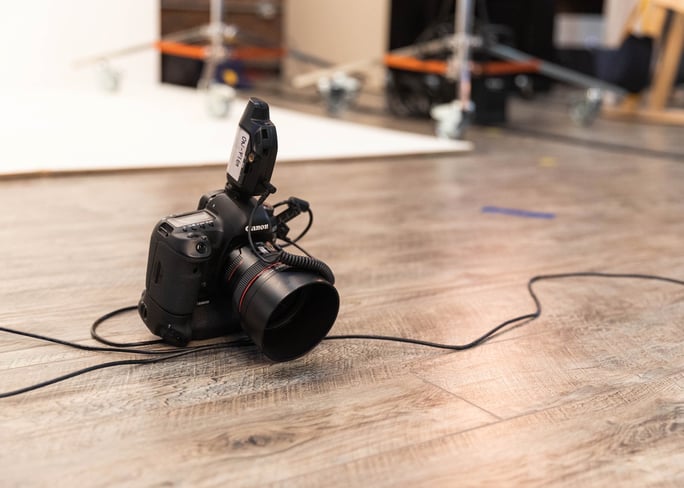Medline’s Digital Content Manager, Ashley Snarski, has a role that, for many of you, looks familiar—sort of. She oversees Medline’s photography studio and post-production team, but she does so from within Medline’s eComm content team, not its production team.
That unique organization structure caught the attention of Daniel Jester, host of The Creative Operations Podcast—enough that he brought Ashley on the podcast to explain how this came to be and how it benefits Medline. It’s not new for web teams and production teams to work in tandem, but Medline’s division of responsibilities is an unconventional take that could have the rest of us double-checking if we’re working in our best possible flow.
To hear the full chat and figure out what, if anything, your organization should mimic, stream Ashley and Daniel’s talk on Amazon Music, Apple Podcasts, Spotify, or our website. Or simply read on for a few key takeaways.
How Medline Came to Place Post-Production Under the Web Team
When Ashley started at Medline, she inherited an existing process with a single point of contact coordinating shoots, organizing samples, clipping, editing, and posting.
“Three to four months after I was hired, our company created our eCommerce division and essentially split us out from marketing,” Ashley says. She understood that scaling would require more organization of creative content, and Medline supported her initiative. Ashley stepped into a larger organizational role but from within the eComm team. “I took what we had and kind of made it as efficient as I could without splitting it off too much.”
As Daniel puts it, Medline has “moved the dividing line from after post-production, which is more typical in our industry, to before post-production.” Assets change departments right after photography. The web team is tasked with applying any needed post-production and getting images online.
So what’s the skill set of someone working on Ashley’s post-production crew within the web team?
Being on the web team, these people have more of a coordinator role, Ashley says. They know how to retouch, clip, and so on. But in Ashley’s structure, they work a lot with outsourced vendors. When images come back, this post-production team adds any remaining touches needed from vendor-provided imagery, and then they think more like merchandisers—deciding which product images they should use on a given product page, or making tough calls if a vendor’s imagery simply isn’t acceptable.
“They are the ultimate team members making those merchandising decisions, and ultimately making sure we're adhering to our brand and standards as well,” Ashley says.
eComm Post-Production Team Maintains Fast Time to Web
OK, so we understand how Medline does things but is their process effective? Is it something any other organization would want to replicate?
One thing they have going is a quick time to web. They’ve brought their timeline from initial request to online down to eight days, often less.
As of a year ago, that number was higher—more in the range of 15 to 20 days, especially for new photography, Ashley says. But then Ashley and her team worked on ways to get samples sooner and automate more of their post-production process.
To Ashley, the biggest change came when Medline’s studio team was empowered with the capability to order product. “We still work with divisions—they still send us product, and we get product a number of different ways—but we have the ability to order it ourselves now,” Ashley says. “So we have that internal ability to work with our product divisions to order it for them because we know that we're faster.”

Medline’s Post-Production Structure Merges Imagery and Copywriting
Ashley works on the eComm team alongside a counterpart who leads Medline’s copywriting team. By working together—specifically at the post-production stage—Ashley and her colleague are better able to control the outcomes of imagery and copywriting so that they’re serving each other.
“We just had some extra product in the studio the other day,” Ashley recalls. "And I brought something in to give out—generic gloves or something people might find useful at home. And [my colleague] was looking at some of the products and she's like, ‘Ah, all of this content on this product packaging is so useful for our copywriting team!’ We try to align our processes at the same time.”
It’s just one example, but by having post-production under eComm as part of an org chart where images and copy are managed side by side, the two can inform each other more.
Post-Production Within eCommerce Helps Reduce Missing Images
Every eComm brand will occasionally have missing images or copy on a product page, whether due to oversight or lag. But by bringing post-production under the eCommerce team, Medline gives Ashley more control to quickly remedy the gaps.
“We're able to tackle what we call our missing images,” she says. “So they're online but missing images or they’re missing other content, like copywriting or attributes. We can tackle that as a team because my counterpart is the manager of copy. We can tackle projects together, even, where they're enhancing copy and we're enhancing images. We have a database where our first priority is always that bucket of missing images so we can fulfill and have fewer gaps on our website.”
While you may or may not be ready to send your post-production team down the hallway to work under a different division, there’s plenty to consider about Medline’s unique flow. For Ashley’s full chat with Daniel, catch the episode on Amazon Music, Apple Podcasts, Spotify, or our website.